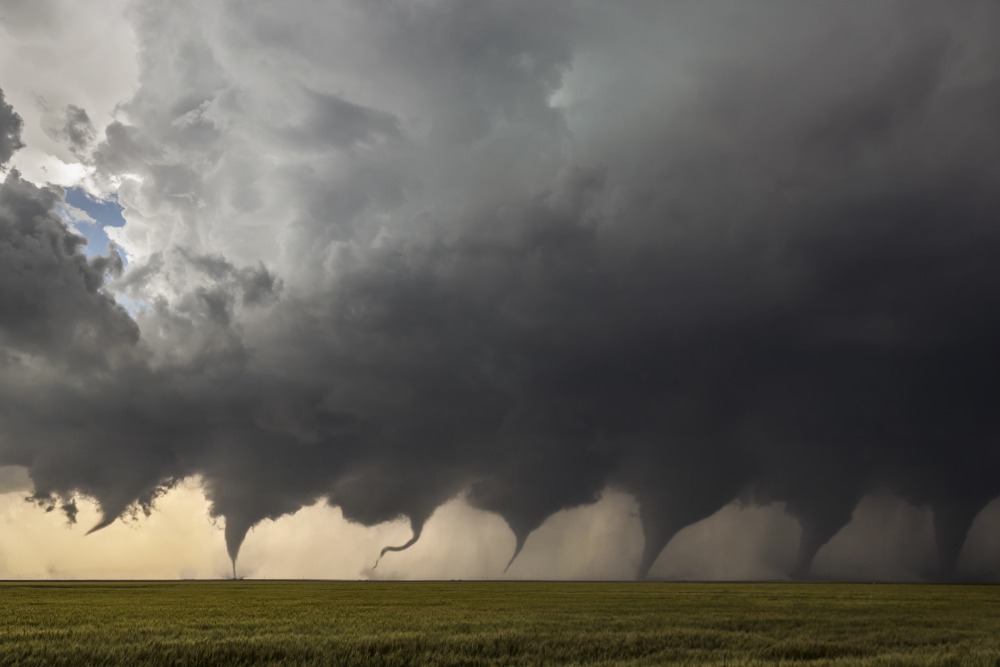A tornado is a rotating column of air that touches the land, often connected to the base of a thunderstorm. The direction of spin is typically influenced by the hemisphere it’s in, but some very rare tornadoes have bucked the trend. With windspeeds sometimes topping hundreds of miles an hour, they can have enormously devastating potential, picking up objects, animals, and even buildings as they tear through the landscape.
Despite this incredible power, people have survived them. So, what happens if you get sucked into a tornado?
“Words cannot describe what it felt like. Beyond horrifying. I am lucky to be alive for sure.”
It can be difficult to avoid tornadoes as they’re not always easy to see because wind, however violent, is invisible. Sometimes, the first sign that one is approaching is the infamous “freight train” rumble, and there are also sounds that indicate a tornado is coming which human ears can’t hear.
When we see that classic movie-like tornado cone, that’s when it has developed a condensation funnel that the National Oceanic and Atmospheric Administration (NOAA) says is made up of water, dust, and debris. The most destructive of them stem from rotating thunderstorms known as supercells, something that meteorologists can spot as they have a well-defined appearance on radar called a mesocyclone. It’s thought that differences in the temperature of this mesocyclone can influence how likely a tornado is to form, but there’s still a lot we don’t know about why and where they’re most likely to appear.
Their strength is measured with the Enhanced Fujita (EF) Scale, a retrospective rating that goes from 0 to 5 by assessing the wind speeds and damage caused by a tornado. The kind of damage taken into account includes the destruction of everything from small barns to high-rise buildings, demonstrating their immense destructive power.
Hardly surprising given the EF Scale rounds off at windspeeds of 512 kilometers per hour (318 miles per hour), in a category that encompasses: “Strong frame houses lifted off foundations and carried considerable distances to disintegrate; automobile sized missiles fly through the air in excess of 100 meters [328 feet]; trees debarked; steel reinforced concrete structures badly damaged.”
If it can lift a house and dump it in a new location, it can certainly lift a human. So, what’s happened to people who have gone into a tornado?
This composite of 8 images shows a tornado forming north of Minneola, Kansas on May 24, 2016.
Image credit: JasonWeingart CC BY-SA 4.0, via Wikimedia
What happens if you get sucked into a tornado?
The NOAA gathered tornado survivor stories that – fair warning – make for a harrowing portfolio of first-person accounts, many of whom feel lucky to be alive. Among them were a couple that actually went into the tornado, here’s what they said:
Cheri, Bryan TX, 2019
I ran to the bathroom, laid down on the floor and grabbed the toilet knowing it was bolted to the ground. In the next 2-5 seconds, I saw the corner of the shop and bathroom lift up and disappear over me. Then I was hit with a force I can’t describe and felt myself being lifted into the air traveling backwards at what seemed like 100 mph [161 kmph]. I was being hit from all directions by objects and beams from the building.
A thousand thoughts went through my mind and I just knew I was dead. I prayed for God to save me then I was slammed back onto the ground. I realized I was alive and did not think I was hurt [too] badly. Then the debris started falling out of the sky. I thought, oh great, I survived being sucked up into the air in a tornado, now I’m gonna be crushed to death!
A single supercell can give rise to several tornadoes.
Image credit: Justin1569 CC BY-SA 3.0, via Wikimedia
Chris Tuveng, Dallas, Texas, 2019
When I got to the Little Caesars they had run out of pizzas. So I had to wait. While I was waiting the Tornado hit the shopping center and sucked me out of the building. I was literally standing inside the Tornado. I found a support column to hold on to at first. Then it spun me off the column and onto a truck that was parked in front of the Little Caesars. I tried holding on to the hood of the truck but there was nothing to hold on to. I ended up on the ground holding on to the rim of the left front tire until it stopped.
The Tornado was an EF3 with sustained winds of 140 mph [225 kmph] and it was 1,300 yards [1,189 meters] wide at its base. That is 13 football fields wide. Words cannot describe what it felt like. Beyond horrifying. I am lucky to be alive for sure. I don’t think you will meet many people in your life who have survived something like this.
What to do in the event of a tornado
Despite the ferocity of tornadoes, the NOAA reports that even the worst of them typically have a 99 percent survival rate, but that doesn’t mean it isn’t worth taking all available precautions to avoid winding up inside one. For the best advice on what to do in the event of a tornado, whether you’re in a car, at home, or outside, visit their safety advisory.
And while we’re on violent phenomena, ever wondered what happens if you get sucked into a whirlpool?
All “explainer” articles are confirmed by fact checkers to be correct at time of publishing. Text, images, and links may be edited, removed, or added to at a later date to keep information current.
Source Link: What Happens If You Get Sucked Into A Tornado?
